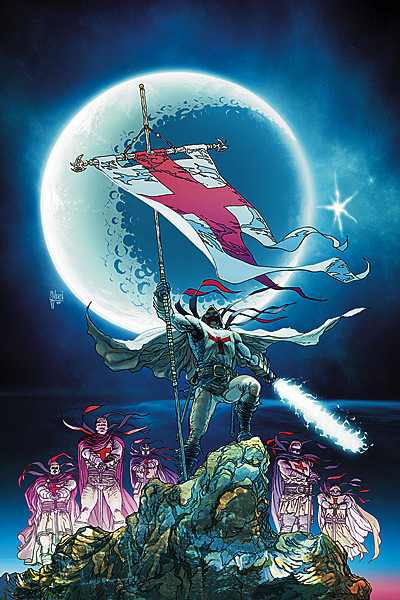Azrael 17
Reviewed by Peter Campbell 15-Feb-11
Appearing several years too late to get caught up in the sales wake of The Da Vinci Code, here comes Azrael. He’s dressed in the costume of a crusading knight, carries a fiery sword…and wears a face mask. Question: if you’ve returned from the dead, as Azrael has, why are you bothering to hide your identity?
Appearing several years too late to get caught up in the sales wake of The Da Vinci Code, here comes Azrael. He’s dressed in the costume of a crusading knight, carries a fiery sword…and wears a face mask. Question: if you’ve returned from the dead, as Azrael has, why are you bothering to hide your identity? It’s one of a number of inconsistencies in a comic that takes itself seriously but which ultimately fails to realise its own ludicrousness.
The story: After some tosh about the Turin Shroud, Azrael departs to Afghanistan to find The Fireball, an Afghani who has the ability to incinerate people by sending opaque bolts of energy from his eyes while clenching his fists very, very tightly. He’s fallen into the hands of the The Brothers of the Sword, a particularly fanatical branch of the Mujahideen. Cue the arrival of Azrael, who comes galloping in on a horse, waving a fiery sword, and who proceeds to slaughter everybody.
Now, conceptually, this is interesting. Hine takes great pains to examine the conflict in Afghanistan on a human level, and his view of Azrael is less than sympathetic. He’s tackling touchy subjects, secure in the knowledge, perhaps, that the comic is due for cancellation shortly. It’s all rather unsubtly done though, with the motivations of the fireball character driven by revenge for the death of his family. The dialogue is adequate, but a little clunky (“Kill him! In the name of God, send his soul to hell!”). It’s all just a bit overly earnest, really.
If you’re going to create a comic about the conflict in Afghanistan, then a comic about a costumed, supernatural superbeing is probably not the best way to go about it. And if you are going to go down that route, then at least revel in the ludicrousness of it all while making your point. The problem isn’t necessarily that Hine has chosen this genre to examine a difficult political situation; it’s that he’s too cautious in his execution, he doesn’t go far enough.
The art, by Cliff Richards, is solid but unremarkable, and his characters have a tendency to have a slightly lumpen feel, perhaps accentuated by his use of overly heavy black lines. At the same time, he can draw, and his abilities stretch beyond a few stock poses, which is more than can be said for many comics artists these days. His work has a strong sense of atmosphere, helped immeasurably by Tomeu Morey’s muted, subtle colouring, which is perhaps the most impressive element on show here.
It’s good to see a mainstream comic take risks, but at the same time, what you end up with is something that’s not hugely removed from an average, dumb comic book. Kudos to its creators for attempting to try something that’s a little bit different: I just wish that it had been more successful in its final execution.
Tags: Azrael, Cliff Richards, David Hine, DC
I don’t know that superheroes generally hide their identity to protect that identity so much as their supporting cast loved ones.
Either way, Azrael’s mask is considerably less dumb than Galactus’.
Garth Ennis’ Punisher run included an excellent arc set in Afghanistan, mature readers but still reasonably mainstream. It’s just a pity that Frank Miller’s Holy Terror, Batman! seems to have vanished into the etherm because that sounded like it would make a pleasingly ludicrous entry at the other end of the scale.
Galactus wears his mask because he fears retribution attacks on Mrs. Galactus.